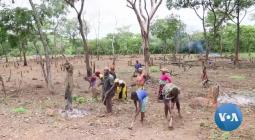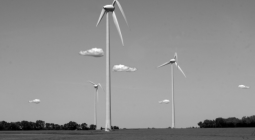Revealed (The Guardian): the places humanity must not destroy to avoid climate chaos
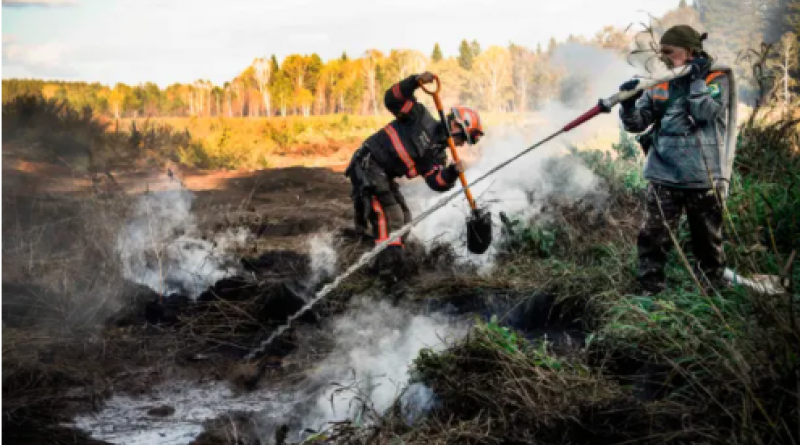
Tiny proportion of world’s land surface hosts carbon-rich forests and peatlands that would not recover before 2050 if lost.
Detailed new mapping has pinpointed the carbon-rich forests and peatlands that humanity cannot afford to destroy if climate catastrophe is to be avoided.
The vast forests and peatlands of Russia, Canada and the US are vital, researchers found, as are tropical forests in the Amazon, Congo and south-east Asia. Peat bogs in the UK and mangrove swamps and eucalyptus forests in Australia are also on the list.
The scientists identified 139bn tonnes (GT) of carbon in trees, plants and soils as “irrecoverable”, meaning that natural regeneration could not replace its loss by 2050, the date by which the net global carbon emissions must end to avoid the worst impacts of global heating. In the last decade alone, farming, logging and wildfires have caused the release of at least 4GT of irrecoverable carbon, the researchers said.
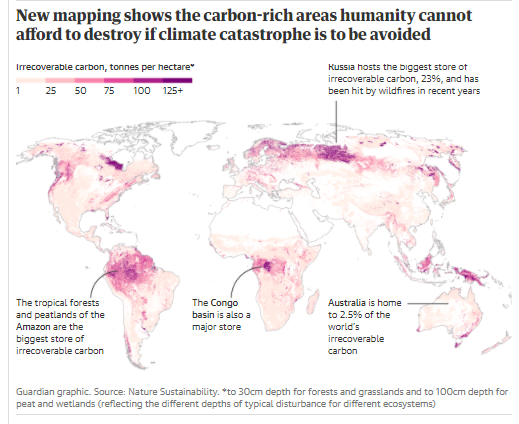
Slashing fossil fuel burning is key to ending the climate crisis but ending the razing of forests is also crucial. Major nations including Brazil, China and the US agreed to do this by 2030 at the Cop26 climate summit, although a similar pledge made in 2014 failed.
The Earth’s irrecoverable carbon is highly concentrated, the researchers showed. Half of it is found on just 3.3% of the world’s land, making focused conservation projects highly effective. Only half the irrecoverable carbon is currently in protected areas but adding 5.4% of the world’s land to these would secure 75% of irrecoverable carbon, they found.
Indigenous peoples are the best protectors of land but only a third of irrecoverable carbon is stored on their recognised territories. Irrecoverable carbon stores overlap strongly with areas of rich wildlife, so protecting them would also tackle the looming mass extinction of wildlife.
“We absolutely must protect this irrecoverable carbon to avert climate catastrophe – we must keep it in the ground,” said Monica Noon at Conservation International, the lead author of the study. “These are the areas that really cannot be recovered in our generation – it is our generation’s carbon to protect. But with irrecoverable carbon concentrated in a relatively small area of land, the world could protect the majority of these climate-essential places by 2030.”
Prof Pete Smith, at the University of Aberdeen in the UK, said: “This research makes a convincing case for where, and how, to focus efforts for the ‘30 by 30’ initiatives already in existence” to protect 30% of land by 2030.
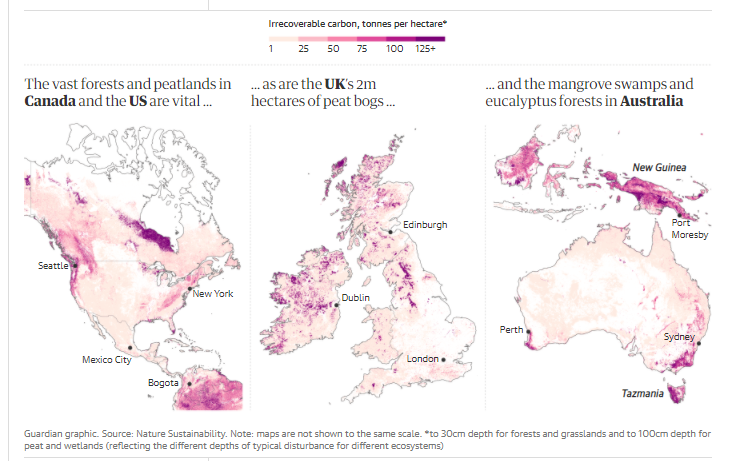
The research, published in the journal Nature Sustainability, found that 57% of irrecoverable carbon was in trees and plants and 43% was in soils, especially peat. Global peatlands store more carbon than tropical and subtropical forests, it concluded.
The tropical forests and peatlands of the Amazon are the biggest store of irrecoverable carbon. These were recently reported as emitting more carbon than they absorb. The boreal peatlands and forests of eastern Canada and western Siberia, and the rainforests islands of south-east Asia, are the next largest. The temperate rainforest of north-west North America, mangroves and tidal wetlands around the world, and the Congo basin are also major stores.
Russia hosts the biggest store of irrecoverable carbon – 23% – and has been hit by wildfires in recent years. Brazil is second, where Jair Bolsonaro’s government has allowed a sharp rise in deforestation. Canada is third and the US fifth: together these countries have 14% of the world’s irrecoverable carbon, but they have also lost forests to wildfires, pests and logging. The wetlands of southern Florida are another important store of irrecoverable carbon.
Australia is home to 2.5% of the world’s irrecoverable carbon, in its coastal mangroves and seagrasses as well as forests in the south-east and south-west, which were hit by megafires in 2019-20. In the UK, peat bogs cover 2m hectares and have stored 230m tonnes of irrecoverable carbon for millennia, but most are in poor condition.
The scientists calculated the amount and location of irrecoverable carbon by first identifying at high resolution those areas where direct human activity could damage natural ecosystems. These included forests and peat wetlands, but excluded permafrost regions and commercial tree plantations.
Next the scientists assessed the total amount of carbon stored in the trees, plants and soils in the included areas. Finally, they estimated how much carbon could be recovered by natural regeneration over 30 years if the forests or wetlands were destroyed.
The difference between the total carbon and recoverable carbon gave the amount of irrecoverable carbon. Losing this irrecoverable carbon would blow the carbon budget needed to have a two-thirds chance of staying under 1.5C of global heating.
Peatlands and mangroves are hotspots of irrecoverable carbon, due to their high carbon density and long recovery times of centuries or more. Tropical forests are less dense in carbon and regrow relatively fast, but remain critical because of the very large areas they cover.
The scientists said protecting irrecoverable carbon must involve strengthening the rights of indigenous peoples, ending the policies that enable destruction and expanding protected areas.
Rob Field, a conservation scientist at the RSPB in the UK, said: “Protection of irrecoverable carbon, coupled with widespread decarbonisation of the world’s economies, will make a safe climate more likely, at the same time as conserving important areas for biodiversity.”
18 November 2021
The Guardian


